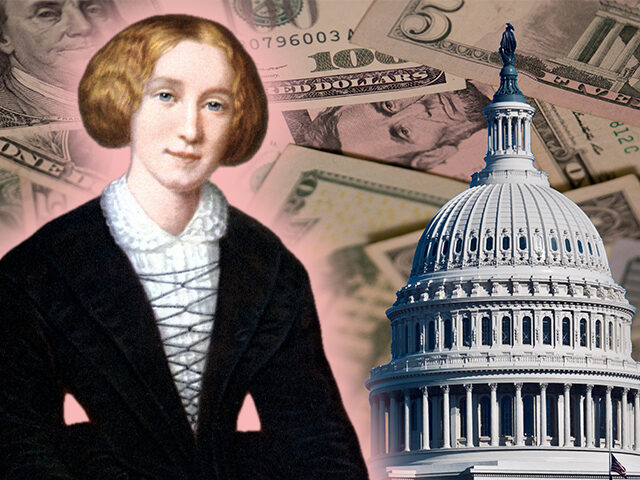Our Budget Deficit Sweet Tooth
George Eliot’s short story “Brother Jacob” begins with a warning about the danger of the desire to be a provider of sweets.
“Among the many fatalities attending the bloom of young desire, that of blindly taking to the confectionery line has not, perhaps, been sufficiently considered,” Eliot writes.
What precisely is the danger that has been insufficiently considered? It’s the danger of inflation. When too many treats are produced and consumed, they lose their ability to delight.
“How is the son of a British yeoman, who has been fed principally on salt pork and yeast dumplings, to know that there is satiety for the human stomach even in a paradise of glass jars full of sugared almonds and pink lozenges, and that the tedium of life can reach a pitch where plum-buns at discretion cease to offer the slightest excitement?” Eliot writes.
The story tells a tale of a young man named David Faux who is dissatisfied with his place in life and absconds to the West Indies. After some unspecified adventures, he arrives back in England in a place called Grimworth, where he sets himself up with a new identity under the name David Freehly as a confectioner to the local high society types. It all comes crashing down when his “idiot” brother Jacob, who has an unending appetite for David’s sweets, shows up and exposes Freehly’s identity fraud.
The American consumer has been playing the role of Jacob in the contemporary Grimworth of the U.S. economy, our enormous appetite revealing that nothing comes freely. The federal government’s huge fiscal deficits have cooked an economy that is plenty sweet—low unemployment, rapid economic growth—but only at the cost of massive and sticky inflation.
The Sticky Mess of Inflation
This personal consumption expenditure (PCE) price index released this week underscored the persistence of inflation. Durable goods prices are rising once again, defying predictions that they would plateau after declining in the second half of last year. Inflation in services came in at a scorching annualized rate of 7.4 percent.
The narrative that inflation was on its way out is becoming harder to advance in light of the data. Overall PCE inflation rose 0.3 percent in January, up from December’s 0.1 percent. Core PCE inflation, which excludes food and energy prices, rose by an even more rapid 0.4 percent, up from 0.1 percent in November and December. In other words, after a mere two months of steady prices, inflation’s upward trajectory has returned.
The revival of inflation does not appear to be linked to any fluke in the data or supply shock. Measures that exclude the outliers tell the same tale as the headlines. Median PCE, which is calculated by the Cleveland Fed, rose by 0.4 percent, twice the rate of inflation that prevailed in the previous three months. The Dallas Fed’s 16% Trimmed Mean inflation measure rose at an annual rate of five percent, the fastest rate since January of last year.
Since there is no ongoing economy-wide supply constraint, it is very clear our current inflation is being driven by excess demand for goods and services. That is the very thing that monetary policy is thought to be able to curtail—which is why it would not make much sense for the Fed to start cutting rates.
The Real Story of Real Rates
The best argument that the advocates for rate cuts can muster is that “real rates”—the nominal interest rate minus inflation—have risen, which in theory should result in a tighter stance of monetary policy. But there simply is no evidence that monetary policy has tightened in a way that would retrain inflation or the real economy. Even some of the parts of the economy that are commonly thought of as “rate sensitive” are booming, including house prices and equity prices.
The prolonged phenomenon of extremely low unemployment and a high number of job vacancies is combining with wealth effects from the buoyant stock market and rising home values to encourage consumers to keep on spending. And with wages rising at a rate inconsistent with the Fed’s two percent target, there’s little reason to expect the consumer to pull back.

Federal Reserve Board Chairman Jerome Powell speaks during a news conference on February 1, 2023, in Washington, DC. (Kevin Dietsch/Getty Images)
There are some analysts who think the jobs data is flawed. They argue that the job openings numbers are somehow double counting or counting phantom jobs. Or that payrolls are overstated. But if that were the case, consumer spending would be weaker. The strength of personal consumption expenditures indicates that the labor market really is as tight as it seems.
Debasing the Currency and the Border
Eliot’s last literary work was published in 1879, one year before her death. It was a novel disguised as a collection of essays titled Impressions of Theophrastus Such, in which Eliot’s titular character complains about the “debasing of the moral currency.”
This is, to our knowledge, the first appearance in English literature of the idea of the wage-price spiral whereby a fall in the value of the currency gives rise to a demand for higher wages. Eliot writes:
This is what I call debasing the moral currency: lowering the value of every inspiring fact and tradition so that it will command less and less of the spiritual products, the generous motives which sustain the charm and elevation of our social existence–the something besides bread by which man saves his soul alive. The bread-winner of the family may demand more and more coppery shillings, or assignats, or greenbacks for his day’s work, and so get the needful quantum of food; but let that moral currency be emptied of its value–let a greedy buffoonery debase all historic beauty, majesty, and pathos, and the more you heap up the desecrated symbols the greater will be the lack of the ennobling emotions which subdue the tyranny of suffering, and make ambition one with social virtue.
To return to Eliot’s “Brother Jacob,” we will point out that the wives of Grimworth become so enamored of Faux-Freehly’s confections that they begin to cook the books of their household’s to disguise the costs of their purchases from their husbands.
Our government has adopted a similar policy with respect to disguising the cost of its deficits and still too accommodative monetary policy. That policy is facilitating massive illegal migration.

Latin American migrants take part in a caravan towards the U.S. border in Huehuetan, Chiapas state, Mexico, on June 7, 2022. (ISAAC GUZMAN/AFP via Getty Images)
“The rebound in net international migration over the last two years has been a key driver of growth in the labor force,” analysts at Bank of America wrote in a note Friday. “This surge in labor supply has allowed strong labor demand to persist without overheating the economy.”
Overtime, of course, the new arrivals will consume their production, just as almost everyone does. But in the immediate timeframe of their arrival, migrants can be exploited to produce more than they consume, acting as a disinflationary force, especially on wages.
Before long, however, Jacob will show up and remind us that Freehly is a fraud.

COMMENTS
Please let us know if you're having issues with commenting.